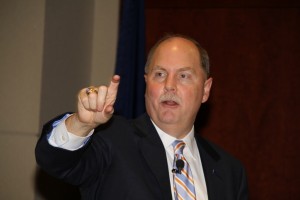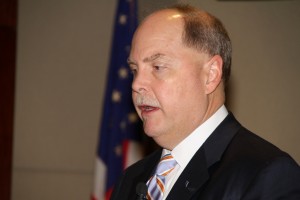
General Motors CEO Fritz Henderson is out to prove the critics wrong and pay back the billions in bailout money loaned by the U.S. Treasury.
October proved to be an unexpectedly good month for General Motors, the carmaker posting its first year-over-year U.S. sales increase since early 2008. In fact, things are looking notably better than the company anticipated when it emerged from its lightning dash through bankruptcy mid-year, said CEO Fritz Henderson.
But it’s also been a time of challenges and sudden, unexpected twists and turns, as was underscored by the GM Board’s decision to back out of the planned sale of a controlling interest in the German-based Opel subsidiary.
Those are some of the subjects Henderson touched on during a breakfast hour meeting at GM headquarters in the Detroit Renaissance Center, today. But the conversation also touched on a subject that clearly motivates the executive as he plans for the automaker’s hoped-for revival: paying back the tens of billions of dollars provided GM by the U.S. Treasury in an unprecedented bailout.

GM CEO Fritz Henderson won't criticize the German government, despite the heat he's taking for calling off the sale of Opel.
TheDetroitBureau: The General Accounting Office issued a study, this week, which said the independent government agency does not expect GM – or Chrysler to fully pay back the more than $80 billion auto bailout. What’s your reaction?
Henderson: It’s my fervent desire to show that report was wrong. (Stakeholders) will get a return based on our ability to create value in our stock. The GAO talked about the prior peak value of our stock (which would not have been enough to fully cover the taxpayer loan). But that was back when there were a huge number of claims on the corporations revenues. Now, after the bankruptcy, everything that’s in front of the shareholder making claims on that revenue has been greatly diminished, so our ability to generate return for the shareholder and drive the value of the stock is greatly increased.
TDB: This has been described as a jobless recovery. What are GM’s plans, going forward? More job reductions?
Henderson: In 2009, we reduced our workforce by about 13,000 hourly people. We still have about 6,000 to 7,000 on layoff. (Those) people are on SUB or TSB (temporary programs designed to enhance traditional unemployment programs), but if they aren’t required, eventually, they will leave the company. But we don’t have another attrition plan. We don’t think it’s necessary.
TDB: You’ve had the industry’s largest incentives. Will they come down?
Henderson: We continued building our 2009 pickups longer than our competitors….and pickups tend to drive incentives. But as we clear out our ‘09s, we will see incentives drop. We’re also clearing out inventory of over-age vehicles, those older than 90 days, which will help. And if we hold down our leasing rates to 6 to 8% of our business, (subsidized) leasing won’t be as big a driver of our incentive spending as it was when we were leasing 22%.
TDB: Your October sales numbers were surprising, and some observers are starting to believe GM may be a bit stronger than they originally expected.
Henderson: We are outperforming our plan (produced during) bankruptcy. Our situation is even more stable than it was two months ago. We didn’t know what would happen when we went into bankruptcy in terms of how the market would treat us. Now, there’s increased confidence the four remaining brands can pick up the pace.
TDB: Consumer Reports recently issued its annual reliability study, and it found GM products “inconsistent,” though it cautiously praised some of your newer models. What happened?
Henderson: We were disappointed with the result – not the report, but the results. We did improve, but we’re not nearly where we should be.
TDB: GM dropped a bombshell, this week, when it decided not to complete the sale of its Opel division. That’s kicked off quite a furor, and the German government is demanding you repay the 3 billion Euro loan that kept Opel running, earlier this year.
Henderson: Obviously, we’ll pay down the loan when it’s due, at the end of November. Our liquidity is enough to do it. Then we’ll resubmit (a request for a government loan) to those countries that have expressed an interest. Things have improve there (in Europe) and, if need be, we can take a royalty holiday.
TDB: There’s a lot of finger-pointing. The Germans and the Opel unions are made at GM. Are you concerned about the German government having tried to force you into the sale?
Henderson: You’re not going to hear any criticism from me of the German government. Let’s face it, if the bridge loan wasn’t in place, Opel would have failed.
TDB: Now what? Will you cut jobs?
Henderson: The business had to be restructured. Anyone’s plan would have done that, Magna’s (a reference to the Canadian supplier that wanted to purchase Opel) or ours. I don’t think anyone could leave things unaddressed. I think the interest of the German government is to have a viable Opel, and in that, our interests are fully aligned.
TDB: Can you say how many of the four German Opel plants you will keep open?
Henderson: No. Our plans call for a substantial reduction in capacity and a reduction in our workforce, but that is something I should tell our people first.
